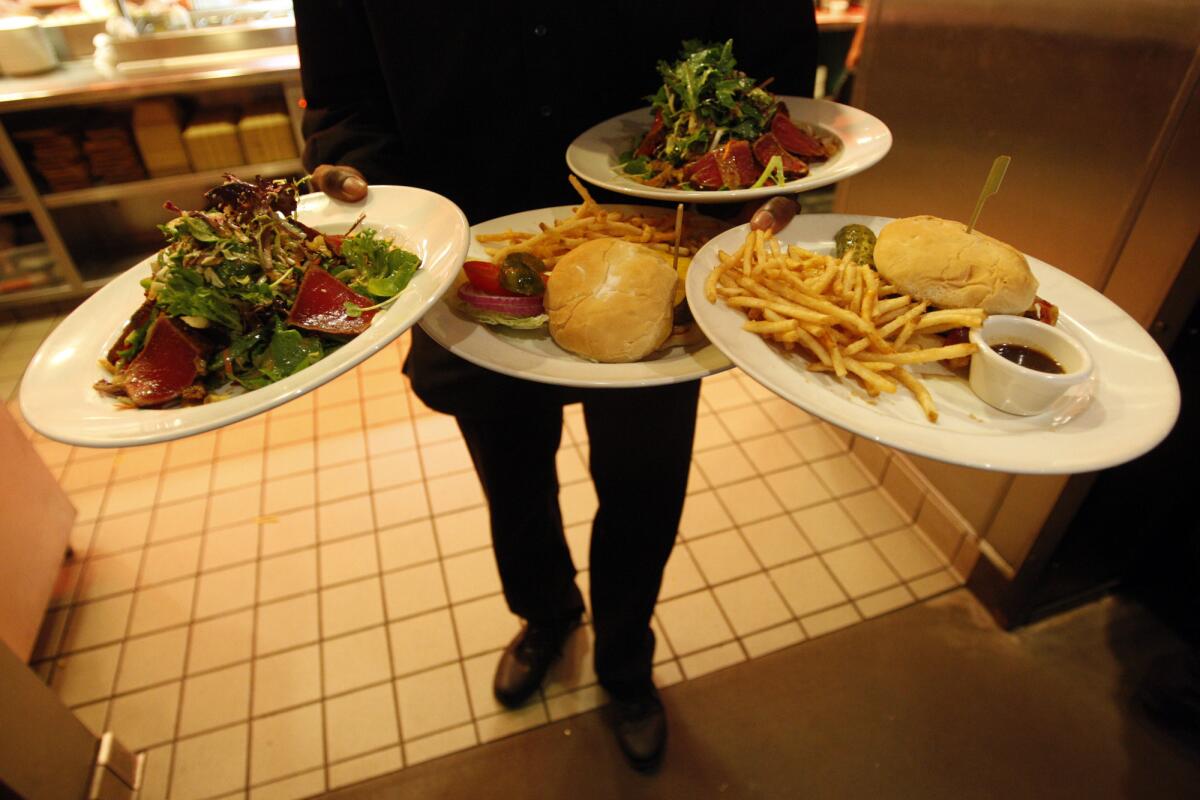FAQ: Everything you wanted to know about tipping

Waiter Branden Adams prepares to deliver lunch to patrons at the Yard House restaurant.
- Share via
Why do we tip?
The American practice of tipping used to not be so American. Several histories of tipping trace it back to a practice adapted from Europeans, whose own history of tipping goes back to at least Tudor England, when overnight guests would leave a small gratuity (or vails) for the house servants. Moneyed Americans, traveling abroad in large numbers after the Civil War (see: Henry James), apparently liked what they saw and brought it back home.
Not that it was immediately welcomed. Far from it: Tipping was considered un-American. Mark Twain famously refused to tip his cab driver. Anti-tipping pamphlets were written and opposition groups popped up across the country. It got so heated that some states even passed anti-tipping laws (all were eventually repealed). The reasons the opposition gave against tipping then are remarkably similar to the reasons in opposition to tipping now: that it creates or exacerbates the class divide between tipper and tippee; that it allows employers to shift part of its wage burden to customers; that it hides the real cost of dining.
How much do we tip?
A 2014 Michelin/Harris poll found that the average American diner tips about 18%. Last year, a Payscale study found that Los Angeles diners similarly leave an 18% tip at restaurants. Studies have shown that how much we tip also depends on many factors unrelated to service, such as the server’s gender and ethnicity, or whether the checks have “Thank You” handwritten on them.
What does the restaurant do with the tip I leave after my meal?
Under state law, tips are the properties of the employees, though exactly how the tips get allocated among the tipped employees varies by restaurant. A common method is for the restaurant to pool all tips earned over a certain period of time — say, a shift, or a week — in a big pot and then to redistribute them to eligible employees according to a formula devised by the restaurant.
Which employees are eligible to participate in a tip pool?
California’s labor statute spells out exactly who cannot receive any tips: Neither the restaurant’s owners nor its agents are permitted to take tips. Agents of the owner include managers and supervisors; essentially, those who supervise other employees, or have the authority to hire or fire employees. Even if they wait on a table, or help deliver dishes, owners and their agents cannot receive any tips.
Only non-supervisor employees who provide service to diners — such as servers, busboys, bartenders, hosts, line cooks and dishwashers — can be part of the pool.
Line cooks and dishwashers? I thought kitchen staff couldn’t participate in the tip pool because they do not provide direct table service?
That was true until a few years ago. In California, the idea that tips may be earned only by those who provide direct table service is rooted in a 1990 appellate court case, Leighton vs. Old Heidelberg, Ltd. The restaurant in question, Old Heidelberg, was the German restaurant of choice if you lived around Van Nuys (there were lederhosen and schnapps). A server, unhappy that the tip pool included busboys and bartenders, sued the restaurant. In validating the restaurant’s tip pool arrangement, the court said that the restaurant “simply followed a ‘house rule’ which is the industry practice, that tips left on table be pooled and distributed among employees who directly provide service to the tipping patron.” That language caught on and was widely interpreted to mean that only those employees who come face-to-face with diners can be included in a tip pool. Which meant that cooks were left out of the pool.
That narrow interpretation of service doesn’t quite correlate with the reality of the dining experience, of course. After all, how much you tip may be just as dependent on a server’s friendliness as it is on whether the steak was cooked correctly. And in 2009, an appellate court agreed. The case was Etheridge vs. Reins International; the tip pool in question included kitchen staff, bartenders and dishwashers. The court, rejecting the idea that only those in the direct chain of service may receive tips, noted that, because the kitchen crew isn’t visible to most diners, it’s critical to include them in a tip pool.
Stephen Berry, a partner at Paul Hastings’ employment law department who also cowrote an amicus brief in support of the restaurant in the Etheridge case, says that the case is still good law in California. And for what it’s worth, the Department of Industrial Relations, the agency entrusted with enforcing the state’s labor laws, notes in its own Frequently Asked Questions that employees who are in the general chain of service may receive tips so long as their role “bears a relationship to the customers’ overall experience.”
But doesn’t federal law say that cooks can’t be part of the tip pool?
Yes and no. The federal law that governs tip pooling is the Federal Labor Standards Act (FLSA), and the Department of Labor’s guidelines explicitly exclude cooks and dishwashers from tip pools. But the 9th Circuit, which has jurisdiction over two territories and nine states, including California, decided in a 2010 case that the tip pool provisions of the FLSA don’t apply to states (like California) that don’t credit tips against an employer’s minimum wage obligations (the so-called “tip credit”) — meaning that a restaurant may include its kitchen staff in its tip pool without running afoul of federal law. As one might expect, the department did not agree, and litigation followed after that. The relevant case, Oregon Restaurant and Lodging vs. Perez, is pending in the 9th Circuit, so the department isn’t enforcing its position on tip pooling in 9th Circuit states — like California — that don’t take the tip credit.
What does tipping have to do with the minimum wage?
In states that take the tip credit, quite a lot. Employers in tip credit states may apply an employee’s tips against their minimum wage obligations, though how much an employer must pay before taking the tip credit varies from state to state. Because California doesn’t permit employers to take the tip credit, employers are required to pay their employees the state’s full minimum wage (currently $10 per hour), regardless of whether the employee also receives tips. Thus in some high-end restaurants, the front of house crew may earn considerably more than the kitchen.
Tien Nguyen is a Los Angeles-based food writer and lawyer.
More to Read
Inside the business of entertainment
The Wide Shot brings you news, analysis and insights on everything from streaming wars to production — and what it all means for the future.
You may occasionally receive promotional content from the Los Angeles Times.









